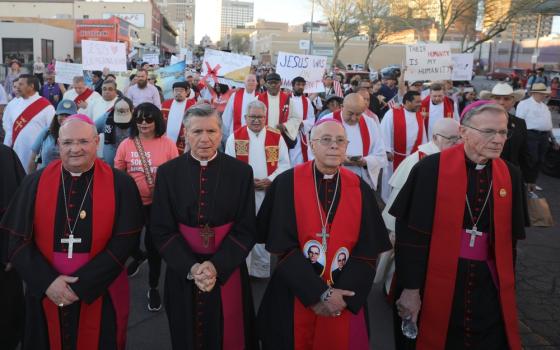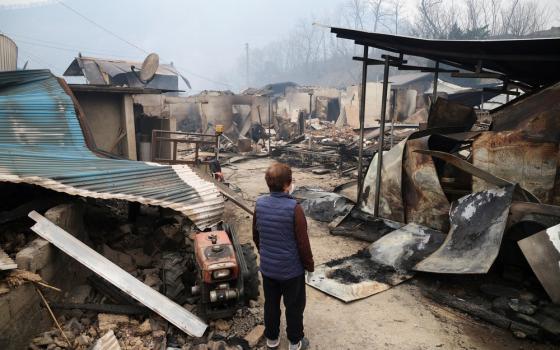
In the late sixties, for the first time I could remember, priests came to the house for dinner. Fr. Eugene was a favorite because he always performed a few magic tricks over coffee. Fr. Ignatius, who oversaw the altar boys, somehow scrounged up enough money from the modest parish fund one Christmas to buy each of us knock-hockey games.
There was Sr. Richard, of course, who taught us folk songs. Sr. Stephan was her best friend. By 1970, they would be allowed to revert to their birth names: Maryann and Karen -- it was a revelation to know them by their actual names, and picture them as real daughters who once wrote their own book reports and drew their own Mother's Day cards. By 1971, they would lose the face-enveloping nun's habits, too, and wear only a small scarf on their heads. But they were never demystified to me. They were always the face of the church in my eyes: only now that face had cheeks and hair -- and a smile.
In 1968, Sr. Maryann and Sr. Karen together decided to touch the third rail of Catholic politics -- a move no doubt inspired by Vatican II, and something conservatives might point to as Exhibit A in their case against the Council and how it ruined the minds of working class believers. I'm talking, of course, about sex.
The sisters decided the fifth grade needed to be taught about sex right way -- before we picked up too much from the street. They worked out a curriculum for separate classes by gender -- Sr. Maryann would teach the boys.
But we would need our parents' permission. I was shaking like a man in the midst of a malarial fever as my mother read through the permission slip. I was racked with regret, astounded by my own stupidity -- no doubt, she'd have dozens of questions I didn't want to answer: why did I, at age 10, feel the need for this class? What, exactly, was I expecting to learn in this class? Why didn't I come to her with these things instead of going to a class?
But then: nothing. My mother nodded to herself, grabbed a ball-point pen from the far regions of her purse, and signed the permission slip. She handed it to me, put on her apron, and stepped into the kitchen to turn on the transistor radio. I sat there for a moment, staring at the signed slip. Mom called out over the sounds of The Association's hit "Windy" and asked if I wanted a snack. I managed a "sure" and folded the paper into my back pocket.
When Sex Ed class started up a week later, every boy from 5th grade but one attended. What could have seemed radical was accepted.
How a nun teaches sex: very carefully. Much clinical discussion about body parts, hormones, and their various functions. Many reminders about how sex is something only husbands and wives did in order to have children. Still, Sr. Maryann's tone was always relaxed, never nervous, and Catholic guilt about the havoc adolescence was soon to bring down on us was completely absent.
But I've got to say this: we never actually got to an explanation of "the act." We did learn about ovum, sperm, etc. -- all, I assumed, a lead-up to discussions of "the act," about which I'd picked up only vague and coded communiqués from older kids on the street. Suddenly, however, it was June: the last class on the last day of school. Finally, desperately, I was compelled to raise my hand and ask in my shaky, pre-adolescent voice: "But how does the sperm get to the ovum?" Sister replied slowly: "It happens at night. The sperm travels to the ovum at night because the mother and father are deeply in love."
Then: the bell rang. The semester and the class were both over. For the last time in our lives, we boys dropped all thoughts of sex in favor of running outside to celebrate summer. I understand now that sister timed it that way, perfectly.
***
Given the current church environment, I'm astounded to think about that class now. Imagine what a Catholic school might have to go through today to teach something similar -- lawyers for the local diocese with reams of contracts, disavowals and disclaimers for parents to sign. Parents demanding to run the teachers through special checks with local law enforcement authorities. But, mostly, cynicism and incredulity -- that members of a Catholic religious order would have anything real to impart on the subject.
That cynicism has nothing to do with Vatican II, but instead with another key church moment that came one month after my fifth grade sex-ed class ended and summer vacation began.
***
In July of 1968, Pope Paul VI issued his famous encyclical banning contraception, Humanae Vitae. Paul overruled a committee of bishops studying the issue and seemed to side with more conservative forces.
 Humanae Vitae marked a change in my house, with my mother. By the late sixties, Immaculate Conception was a Vatican II wonderland of jam-packed "hootenanny" Masses featuring guitars and tambourines. Foreboding statutes of Italian saints were replaced by those brightly-colored banners with free-style felt lettering that called out: He Is Risen! And gospel readings were studied from a hip new book titled, not "The New Testament," but "Good News For Modern Man" -- a perhaps too-contemporary translation into simple English vernacular.
Humanae Vitae marked a change in my house, with my mother. By the late sixties, Immaculate Conception was a Vatican II wonderland of jam-packed "hootenanny" Masses featuring guitars and tambourines. Foreboding statutes of Italian saints were replaced by those brightly-colored banners with free-style felt lettering that called out: He Is Risen! And gospel readings were studied from a hip new book titled, not "The New Testament," but "Good News For Modern Man" -- a perhaps too-contemporary translation into simple English vernacular.
My mother really liked this. She was different in church, more alive than the woman I remembered watching me altar-serve in third grade.
But shortly after July 1968, her attitude toward the church began to shift. Suddenly, it was just "a bunch of old Romans trying to tell everyone what to do." Over the years, my mother still went to Mass but participated less; she told me recently that she now just went to church to get some quiet time for herself with God, and tuned everything else out. She was once again like the old ladies in black of my childhood.
I was much older when I finally did the calendar math and understood why. In 1967, at age 40, my mother became pregnant. I learned about this when I came home from altar practice one afternoon and found her crying in the kitchen uncontrollably, my dad trying to comfort her without success. She'd had one very rough delivery with my brother thirteen years before, and knew the additional risks of pregnancy at her age.
My sister was born in February of 1968. The delivery was easy, but then my mother began to hemorrhage -- nothing could stop it. I was jolted awake in the middle of the night by a slammed door at my grandmother's house, where my brother and I were staying. It was the sound of my father rushing in from the hospital, crying to his mother, desperate now about this delivery, afraid his wife was going to die.
My mom doesn't remember her own mother. In poor health after giving birth to eleven children, she passed away in child birth when my mother was four years old. So, as she lay on the operating table, Mom had one thought in mind: the same fate now awaited her newborn baby girl. I know this, of course, because she did pull through -- thirteen blood transfusions later. The whole saga -- the crying, the bleeding, the surviving -- is one of my family's great stories now, more emotional with every telling. But in 1968, still recovering from her ordeal when Humanae Vitae was issued, my mother fumed at the thought that Rome would tell a woman preventing pregnancy was immoral, no matter the age or the circumstances. What could they possibly know about that?
***
The American ethos into which Italian families in the Bronx were rapidly assimilating assumed people high up needed the consent of the people below, but Humanae Vitae showed the church -- for all its attempts at spiritual democracy -- was not ready for that. The retreat from Vatican II had begun.
Many clergy came to realize this, too -- the energy and optimism they brought to their vocations in the 1960s were increasingly hard to sustain. In 1974, three years after I graduated eighth grade, Sr. Maryann left the Pallotine nuns and Immaculate Conception School. She had spent nearly seven years there and was just a few months shy of taking her final vows. Sr. Karen drove her home, then decided to leave, too.
Years later, Maryann told me she left because the leadership of the Pallotine order was not incorporating enough of the changes from Vatican II, even though rank-and-file nuns wanted this. Maryann noticed that, seven years on, she was still the youngest nun in the convent -- no one had joined since she entered, and the place was losing its vitality.
***
In some conservative Catholic circles, Vatican II may now be viewed as foolishness or worse -- but today, as back then, the real test is on the ground. There, the principles of that era spark the American Catholic church in ways so commonplace, they are taken for granted.
This is Immaculate Conception Church today: still working class and poor, now home to 2,500 families, larger than in 1967. As my family did, most Italians moved out of the Bronx parish and into the suburbs in the late 1970s -- but some remained, now joined by Hispanics and a growing number of African-Americans.
The church has a Web site, on which it proudly proclaims itself "a multi-cultural Catholic community." Proof of that: Immaculate now has four choirs -- an adult gospel choir, a children's gospel choir, a Spanish choir, and a traditional choir. The church will happily sell you a CD it's produced of all the groups.
The 7:00 pm Mass is now the "youth Mass," music provided on alternating Sundays by the "Franciscan Troubadours" and a Folk Choir. It's pretty close to the "hootenanny" services of my time.
The Pallotine sisters left the grammar school about twelve years ago, due to age and reduced numbers. This was the very direction Maryann had foreseen -- not because Vatican II somehow pushed women out of religious life, but because the Council's promised changes regarding that life were too often thwarted. Now ten nuns culled from three other orders work alongside lay teachers.
Still, imagine this parish today without Vatican II: Masses said in Latin, not in Spanish or Italian or English; choirs singing from a small list of approved traditional hymns, with gospel music nowhere to be found; certainly no youth Mass or troubadours.
That's a very different kind of place, and I doubt 2,500 families would want to worship there. Two generations have passed since the Second Vatican Council; people have come to expect more from their church -- successful parishes know that.
This is certainly true where Maryann goes to church -- she's still a Catholic. When I spoke to her recently, she'd just retired after 35 years of teaching special education students in public school -- a sacrifice even more demanding than her days as a nun in The Bronx. She married 21 years ago and heads up a large pride of step-children, step-grandchildren, and, not long ago, the birth of a step-great-grandchild. At her parish, Maryann gives lectures on the Eucharist and the sacraments. The pastor and assistant pastor find lots of ways to use her talents -- though, she tells me, she lets others play guitar and sing at Mass these days.
What would have happened to her without Vatican II? In an isolated world of cut-off clergy, she could have felt too much fear and never left her order, remaining to become one of those bitter nuns that every angry ex-Catholic has apparently encountered. Or she could have found the courage to leave, but then hidden that side of herself, never daring to approach a pastor and get involved in her faith again. The chances of her actually becoming a normal, happy, participating member of the Roman Catholic church would have seemed as theoretical as the number of angels dancing on the head of a pin.
I think about Maryann, my old church and my old school all the time these days, now that I have two daughters of my own. They go to a Catholic grammar school at our Los Angeles parish, where families clamor to get their children in. The school was run for years by a recently-retired nun who didn't even wear the simple head scarf anymore; she was a great feminist role model for my girls, kept a giant jar of candy in her office, and was never the nightmare reason some kid turned away from his or her faith.
There is no towering dome or stained glass in our Los Angeles church -- it is modern, with rivers of natural light and a simple altar. I watch from the blond-wood pews as my older daughter helps with Mass as an altar server. It's yet another memorable scene in my life made possible by the spirit of Vatican II.
The Curia -- in one of its more retrograde moods -- issued a draft document on June 5, 2003 that said using girls as altar servers should be avoided "unless there is a just pastoral cause," i.e., no boys want to do it. Reaction was swift and negative; by late June, the draft was rejected. It seemed few in the pews thought altar girls were anything unusual, and certainly nothing into which Rome should be sticking its nose.
In the Mass now, the priest is holding up the Eucharist. I watch with a nostalgic smile as my daughter energetically rings the tiny set of bells -- for all the changes of the past 40 years, that's still every altar server's favorite part of the job. Her eyes search for me subtly and catch my expression. The same expression my mother used to give me as she watched from the pews. My daughter sends back a slight, proud smile of her own.
That smile is a small victory for her and for everyday parish life as it is now lived. Here in Los Angeles, and back there in The Bronx. And it is another small victory for my Vatican II.
[Editor's Note: The first part of this remembrance appeared last weekend on NCRonline.org.]
Joe Ferullo lives in Los Angeles and works in the television industry. He blogs for NCR at NCR Today.




